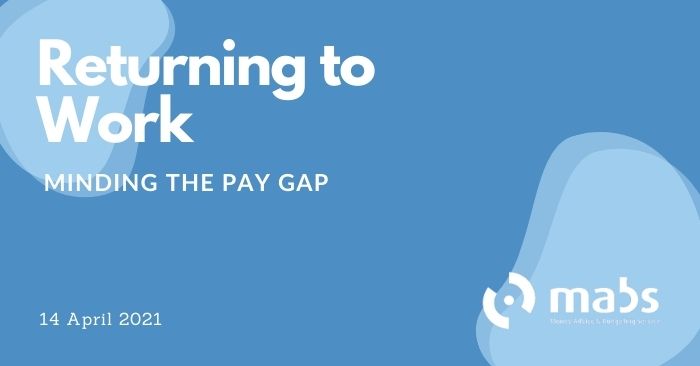Returning to Work – Minding the Pay Gap

Are you on a social welfare payment and expecting to return to work soon? There may be a few weeks between receiving your last social welfare payment and receiving your next wages. Therefore, you might be without any income. Don’t panic, a good starting point is to make a spending plan. This can help you feel more in control, especially if you are the person that keeps track of the money in your household. Follow our four steps to start your spending plan:
Step 1. Work out how much money you have
Work out how much money you have, add up all the money coming into your household every week or month. This can include:
- Social Welfare
- Child Benefit (as this is a monthly payment, divide it by 4 if you are doing a weekly budget)
- Wages
- Money given to you by other adults living with you
You can use the MABS Tools to help you with this.
Step 2. Work out how much money you need
Work out how much money you need to set aside to help you cover this shortfall. Write down the costs of all your essential expenses, such as:
- food
- light and heat
- medical expenses
- housing costs, such as rent or mortgage
- any other essential expenses for you and your family
Step 3. Make your spending plan
Now is the time, if you can, to set money aside from your disposable income to cover this shortfall.
| Total Weekly Income Now | Total Weekly income once social welfare is stopped | ||
| Total weekly essential expenses | Total weekly essential expenses | ||
| Disposable income | Difference |
You may have fewer expenses at the moment, less travel costs, perhaps you have no childcare costs, or you may have noticed other savings in your household expenses? These savings should be set aside now to help you cover the shortfall when you return to work. It is important to note that for some employees, you might be waiting up to 8 weeks for your first wage payment.
Ask yourself, can I spend less on anything now to help save for this shortfall? Can I pay a little extra now to build up credit for my utility bills? Can I buy extra electricity or gas credit?
Step 4. Plan your spending
Once your food, light, heat and medical expenses are covered, your rent or mortgage payments should be your next priority. If you feel you are unable to save enough to cover your rent or mortgage you need to take action now and contact your landlord, mortgage lender or MABS for advice and support.
Check your plan often. Keep track of what you are saving. Know how much money you have left to save in order to cover your essential costs, while you are waiting to get paid. If you stray from the plan, don’t be too hard on yourself. MABS is here to help you get back on track.
MABS is the Money Advice and Budgeting Service. It is a free and confidential service. MABS can give you support if:
- You are worried about money.
- You are repaying a loan or debt.
- You fall behind on bills. MABS can make arrangements with the provider for you to pay a bit every week.
- You are managing on a tight budget. MABS can help you make a spending plan that works for you.
Advisers are available by phone and email and you can message us on WhatsApp 086 035 3141. You can call the MABS National Helpline on 0818 07 2000, Monday to Friday, from 9am to 8pm or find the contact details for your local office here.
Follow @MABSinfo on Twitter and Facebook and Instagram for further updates.




Facebook
twitter
Instagram